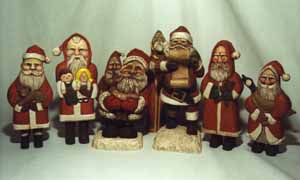
Spencerport man's carvings At first glance, it might seem that Terry Traugh is a collector of fine wood carvings. His Coleman Avenue, Spencerport home is filled with beautiful and whimsical pieces that look as if they were carved by a well-known artist. Traugh is, in fact, the artist who created each of the works, but it is mostly family and friends who know about his talent. Traugh began carving in 1959 when he was transferred as an employee of Eastman Kodak Company to Kingsport, Tennessee. He didn't know many people there, so to pass his spare time, he began whittling neckerchief slides in the shape of little animals for his sons' Boys Scout uniforms. "The boys gave them to their friends as fast as I could make them and the few that they didn't make off with I packed when we moved back to Rochester and put in my attic," he remembered. Fifteen years passed and one day daughter Valerie found a box of carvings in the attic and asked him why he didn't do that anyone. "It wasn't anything I had thought about in a while, but she kept bugging me, so I dug out my patterns," he recounted. It wasn't long after that Traugh learned about a local club, the Genesee Woodcarvers' Club. "They loved to carve water fowl and ornamental birds, so I started with the same," he said. Even though he picked up useful tips, such as the best types of wood to carve, Traugh didn't stick with the club for very long. "I like more variety in what I carve and most of those guys were in to carving with rotary tools. That created too much dust, which I couldn't tolerate for health reasons," he explained. Traugh had been seeking instruction in a more traditional method of carving when he heard about a German master carver, George Kilhoffer, who was now living in Frankenmuth, Michigan, where he taught week-long carving classes. It didn't take long for him to sign up. "That's where I learned how to hold my work securely on a bench, sharpen my tools and use the right tools," he said. "But traditional carving is not something you can learn in a few quick lessons, so beyond that, I'm self taught." With safety as his primary focus, Traugh begins each project by tracing a pattern on a block of wood. Some of the patterns he gets from his favorite magazine," Chip Chats," published by the National Woodcarvers' Association, and some of the patterns he draws himself. Then he cuts out the general shape always being sure to have the wood securely mounted to his workbench. Tools, such as a carver's screw and carver's arm, enable him to chisel at the piece at every angle, without the risk of injury. "That's the difference between a carver and a whittler. A carver doesn't get hurt because he's not holding the wood in his hand while he works," he explained. Traugh also pointed out that he never uses a swing blade and always points the blade away from himself while carving. Traugh soon began working more and more to perfect his craft. "I remember waking up in the morning and there would be this creation on the dining room table that Dad would have been working on all night. He wouldn't mention it. He would just wait for one of us to say something," his daughter, Valerie Bopp, remembered. Carousel horses, rocking horses, ducks, traditional and folk art Santa Clauses, manger scenes - Traugh carved a wide variety of pieces that would disappear as quickly as he could make them, becoming the prized possessions of his family and friends. A couple pieces were even enjoyed by his neighbors - a nearly life-sized bear and Indian carved from a big tree that had been taken down in his backyard. In 1997, Traugh retired from his position as a machine designer at Kodak and remarried. For his wedding, he carved a bride and groom for the top of the wedding cake. Now the couple spends each evening in their family room where his wife, Nancy, relaxes and watches television, and Traugh carves away at his latest project. He said he spends about an hour or two each day carving and that it takes ten days to two weeks for him to finish a project. "That's not nearly fast enough for me to make any money doing this," he said. But even if Traugh did decide to sell some of his creations, chances are his family wouldn't let him. "We know where every piece is that Dad's made," said Bopp. "And each is a part of our family." |
